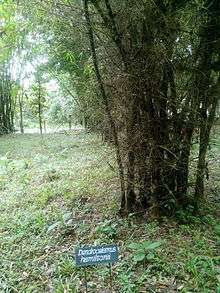Dendrocalamus hamiltonii
| Hamilton's bamboo | |
|---|---|
 | |
| Dendrocalamus harmitonii at the bamboo garden of KFRI (Kerala Forest Research Institute) at Palappilli, Thrissur district, Kerala, India. | |
| Scientific classification | |
| Kingdom: | Plantae |
| (unranked): | Angiosperms |
| (unranked): | Monocots |
| (unranked): | Commelinids |
| Order: | Poales |
| Family: | Poaceae |
| Subfamily: | Bambusoideae |
| Supertribe: | Bambusodae |
| Tribe: | Bambuseae |
| Subtribe: | Bambusinae |
| Genus: | Dendrocalamus |
| Species: | D. hamiltonii |
| Binomial name | |
| Dendrocalamus hamiltonii Gamble | |
| Synonyms | |
| |
Hamilton's Bamboo (Dendrocalamus hamiltonii) is a species of bamboo, 12–15 cm in diameter and growing up to 15–18 m in height, found in South Asian countries such as, India, Sri Lanka, Bhutan, Nepal, Pakistan, and far eastern China.[1]
Habit
It is a tall, dull green-colored bamboo species with drooping tops, which grows in thickets consisting of a few closely growing culms.
Appearance
Culms are dull green covered with whitish-brown hairs, which become dull brownish-green when dry. Whitish bands occur below and above the nodes. Culms are noticeably zig-zag. Branching occurs from the base to top. Aerial roots are present in all nodes. Internode length is 30-40 cm, and diameter is 5-15cm. Culm walls are 0.5-1.5 cm thick. Nodes of some culms are bent.
Culm sheaths are green when young and turn yellowish brown when mature, and are long and gradually tapering upwards from a flattened base. The sheath proper is 18-45 cm in length and 15-28 cm wide. Blade length is 8-20 cm. Auricles are absent. Upper surfaces of the sheaths are covered with patches of blackish-brown hairs. Lower surfaces of the sheaths are not hairy. Sheaths fall off early.
Varieties
- D. h. var. edulis
- D. h. var. hamiltonii
- D. h. var. undulatus